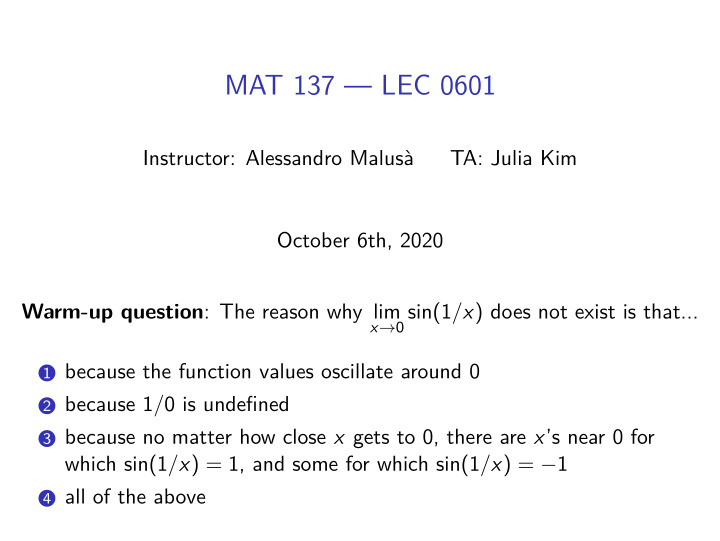



MAT 137 — LEC 0601 Instructor: Alessandro Malusà TA: Julia Kim October 6th, 2020 Warm-up question : The reason why lim x → 0 sin(1 / x ) does not exist is that... 1 because the function values oscillate around 0 2 because 1 / 0 is undefined 3 because no matter how close x gets to 0, there are x ’s near 0 for which sin(1 / x ) = 1, and some for which sin(1 / x ) = − 1 4 all of the above
Limits involving sin(1 / x ) Part II x → 0 x 2 sin(1 / x ) The limit lim 1 does not exist because the function values oscillate around 0 2 does not exist because 1 / 0 is undefined 3 does not exist because no matter how close x gets to 0, there are x ’s near 0 for which sin(1 / x ) = 1, and some for which sin(1 / x ) = − 1 4 equals 0 5 equals 1
A new squeeze This is the Squeeze Theorem, as you know it: The (classical) Squeeze Theorem Let a , L ∈ R . Let f , g , and h be functions defined near a , except possibly at a . IF • For x close to a but not a , h ( x ) ≤ g ( x ) ≤ f ( x ) • lim x → a f ( x ) = L and x → a h ( x ) = L lim THEN • lim x → a g ( x ) = L
A new squeeze This is the Squeeze Theorem, as you know it: The (classical) Squeeze Theorem Let a , L ∈ R . Let f , g , and h be functions defined near a , except possibly at a . IF • For x close to a but not a , h ( x ) ≤ g ( x ) ≤ f ( x ) • lim x → a f ( x ) = L and x → a h ( x ) = L lim THEN • lim x → a g ( x ) = L Come up with a new version of the theorem about limits being infinity. (The conclusion should be lim x → a g ( x ) = ∞ .) Hint: Draw a picture for the classical Squeeze Theorem. Then draw a picture for the new theorem.
Proof feedback 1 Is the structure of the proof correct? (First fix ε , then choose δ , then ...) 2 Did you say exactly what δ is? 3 Is the proof self-contained? (I do not need to read the rough work) 4 Are all variables defined? In the right order? 5 Do all steps follow logically from what comes before? Do you start from what you know and prove what you have to prove? 6 Are you proving your conclusion or assuming it?
Rational limits Consider the function ( x − 1)(2 + x ) h ( x ) = x 2 ( x − 1)(2 − x ) . • Find all real values a for which h ( a ) is undefined. • For each such value of a , compute lim x → a + h ( x ) and lim x → a − h ( x ). • Based on your answer, and nothing else, try to sketch the graph of h .
Before next class... • Watch videos 2.14, 2.15. • Download the next class’s slides (no need to look at them!)
Recommend
More recommend